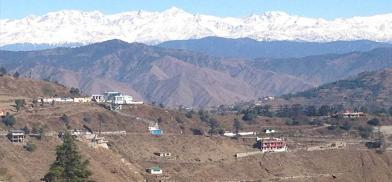100 Chinese soldiers crossed over into Uttarakhand in August: Indian media reports
In yet another reminder that the de facto border between India and China remains contentious in several regions beyond Ladakh, details are emerging about the latest incursion by Chinese forces, this time in Uttarakhand's Barahoti region, north of the Nanda Devi biosphere reserve

In yet another reminder that the de facto border between India and China remains contentious in several regions beyond Ladakh, details are emerging about the latest incursion by Chinese forces, this time in Uttarakhand's Barahoti region, north of the Nanda Devi biosphere reserve. Close to 100 soldiers of China's People's Liberation Army (PLA) transgressed 5 km across the Line of Actual Control or LAC last month, the Economic Times reported earlier this week. The transgression took place on August 30, and the Chinese troops returned after a few hours from the area guarded by the Indo-Tibetan Border Police (ITBP), news agency PTI said.
The report cited people familiar with the matter who said Indian troops responded with a "tit-for-tat strategy" and "carried out patrolling".
There was no official comment on the Chinese transgression. Sources said that there was no damage to any infrastructure in the area. The incident comes amid a continuing standoff between Indian and Chinese troops in several areas in eastern Ladakh though both sides completed disengagement in two sensitive locations.
According to sources quoted by the PTI, minor transgressions have been taking place in Barahoti because of differing perceptions about the LAC by both sides. However, what surprised the Indian officials was the number of Chinese military personnel who transgressed on August 30, they said.
The Chinese side has also significantly ramped up infrastructure development along the LAC in the sector.
India has been maintaining a strict vigil along the nearly 3,500-km LAC following the eastern Ladakh standoff. The border standoff between the Indian and Chinese militaries erupted on May 5 last year in eastern Ladakh following a violent clash in the Pangong Lake area. Both sides gradually ramped up their presence by rushing in tens of thousands of soldiers as well as heavy weaponry.
As a result of a series of military and diplomatic talks, the two sides completed the disengagement process in the Gogra area last month. In February, the two sides completed the withdrawal of troops and weapons from the north and south banks of the Pangong Lake in line with a disengagement agreement. Each side currently has around 50,000 to 60,000 troops along the Line of Actual Control (LAC) in the sensitive sector, NDTV said.
Meanwhile, a day after Beijing identified New Delhi’s decision to pursue a “forward policy” and illegal crossing of the Line of Actual Control (LAC) to encroach into China’s territory as the “root cause of tension” in the border situation, India rejected the claims and said the “amassing of (a) large number of troops by the Chinese side and their provocative behaviour” has led to the current military standoff.
Responding to remarks by the Chinese Foreign Ministry, Ministry of External Affairs spokesperson, Arindam Bagchi, said, “We had already made our position clear a few days back that we reject such statements which have no basis in facts.”
“It was the amassing of a large number of troops by the Chinese side, their provocative behavior and unilateral attempts to alter the status quo in contravention of all our bilateral agreements that resulted in serious disturbance of peace and tranquility along the LAC in eastern Ladakh,” Bagchi said.
He said that China continues to deploy a “large number of troops and armaments in the border areas”.
“It was in response to Chinese actions that our armed forces had to make appropriate counter-deployments in these areas to ensure that India’s security interests are fully protected,” Bagchi said.
As emphasised by Indian External Affairs Minister S Jaishankar in his meeting with his Chinese counterpart Wang Yi earlier this month in Dushanbe, Bagchi said, “it is our expectation that the Chinese side will work towards early resolution of the remaining issues along the LAC in eastern Ladakh while fully abiding by bilateral agreements and protocols.”
On Wednesday, Chinese Foreign Ministry spokesperson Hua Chunying had said, “The Indian side has long pursued the ‘forward policy’ and illegally crossed the LAC to encroach on China’s territory, which is the root cause of tension in the China-India border situation. China opposes any arms race in the disputed border areas for the purpose of competition over control.”
She had said that China has always been firm in safeguarding national territorial sovereignty and security, and committed to peace and stability in the border areas. Last week, India had rejected China’s claim that the Galwan Valley incident took place because India violated all agreements and encroached upon China’s territory (SAM)













Post a Comment